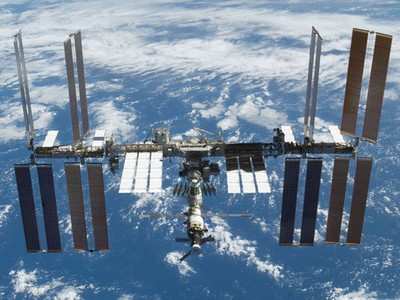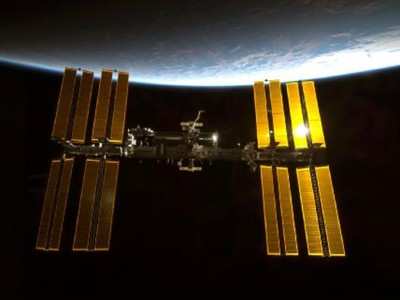Thu, Apr 28, 2011
Pledges To Support ISS Operation Until At Least 2020
The Multilateral Coordination Board (MCB) for the International
Space Station partner agencies met Wednesday, April 27, to discuss
increased efforts to use the station as a test-bed for exploration.
The MCB also congratulated the European Space Agency (ESA) on its
recent decision to continue station operations to at least
2020.

The MCB is working diligently to extend the benefits to future
exploration beyond low-Earth orbit through enhanced station
research, technology development and other opportunities. Other
topics on the agenda included a report on efforts to create
international standards for docking and berthing; rendezvous and
proximity operations; interfaces for replaceable items and
payloads; and standardization of command protocols for
spacecraft.
Station research with potential societal impact includes:
- The Alpha Magnetic Spectrometer-2, which will fly aboard
STS-134, scheduled to launch on April 29. The experiment is a
cosmic ray detector that will search for dark matter and
antimatter, components critical to understanding the origin and
structure of our universe.
- The Canadian Space Agency (CSA) continues its life science
research program on mitigating health risks associated with
spaceflight. These health experiments and activities will monitor
crew health and deliver health care on space missions.
- ESA began the GeoFlow experiment in the Fluid Science
Laboratory payload. This experiment will take advantage of the
microgravity environment on the station in combination with
electrical fields, thermal gradients and rotation to simulate many
parameters of geo-physical flows under the Earth's crust. Results
will help scientists understand thermal convection in planets and
the outer shells of celestial bodies. It also will verify numerical
simulations of fluid dynamics of liquid core planets with real
experimental data.
- Roscosmos, the Russian Federal Space Agency, continues
experimental programs aimed at human adaptation to future long-
term expeditions. Dedicated medical experiments study the effects
of flight conditions on the cardiovascular system, respiratory
system and bones. Other research includes planting wheat and
vegetables them performing genetic, microbiological and biochemical
tests on the plants.
- Japan has found several new X-ray celestial bodies by the
Monitor of All-sky X-ray Image instrument of "Kibo" and recently
reported the new gamma rays outburst of the Whale or Cetus. This
discovery will contribute to understanding the origin and the
evolution of the universe. Japan has also implemented a new
investigation on cucumber seedlings to study how plants sense
gravity as an environmental signal and use it for governing their
structural development and growth orientation.

The governments of Japan and the Russian Federation already have
approved continued station operations beyond 2016. NASA received
approval in the NASA Authorization Act of 2010. CSA is working with
its government to reach consensus about the continuation of the
station.
The MCB includes senior representatives from NASA, CSA, ESA,
Roscosmos and the Japanese Ministry of Education, Culture, Sports,
Science and Technology. The MCB meets periodically to ensure
coordination of station operations and activities among the
partners.
More News
Airbus Racer Demonstrator Makes Inaugural Flight Airbus Helicopters' ambitious Racer demonstrator has achieved its inaugural flight as part of the Clean Sky 2 initiative, a corners>[...]
A little Bit Quieter, Said Testers, But in the End it's Still a DA40 Diamond Aircraft recently completed a little pilot project with Lufthansa Aviation Training, putting a pair of >[...]
Line Up And Wait (LUAW) Used by ATC to inform a pilot to taxi onto the departure runway to line up and wait. It is not authorization for takeoff. It is used when takeoff clearance >[...]
Contributing To The Accident Was The Pilot’s Use Of Methamphetamine... Analysis: The pilot departed on a local flight to perform low-altitude maneuvers in a nearby desert val>[...]
From 2015 (YouTube Version): Overcoming Obstacles To Achieve Their Dreams… At EAA AirVenture 2015, FedEx arrived with one of their Airbus freight-hauling aircraft and placed>[...]
 Airbus Racer Helicopter Demonstrator First Flight Part of Clean Sky 2 Initiative
Airbus Racer Helicopter Demonstrator First Flight Part of Clean Sky 2 Initiative Diamond's Electric DA40 Finds Fans at Dübendorf
Diamond's Electric DA40 Finds Fans at Dübendorf ANN's Daily Aero-Term (04.23.24): Line Up And Wait (LUAW)
ANN's Daily Aero-Term (04.23.24): Line Up And Wait (LUAW) NTSB Final Report: Extra Flugzeugbau GMBH EA300/L
NTSB Final Report: Extra Flugzeugbau GMBH EA300/L Classic Aero-TV: 'Never Give Up' - Advice From Two of FedEx's Female Captains
Classic Aero-TV: 'Never Give Up' - Advice From Two of FedEx's Female Captains




